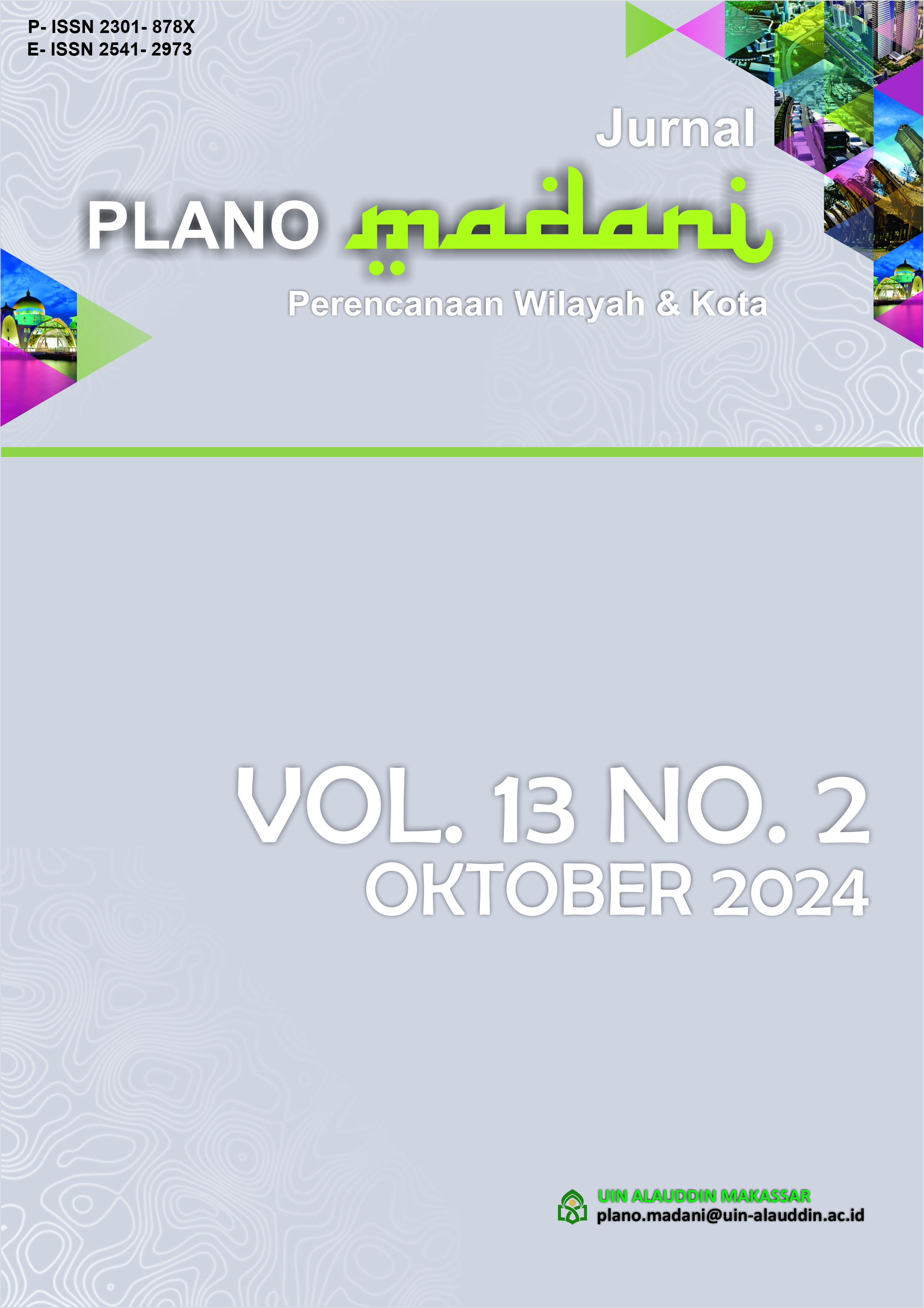COMPARISON OF WEIGHTING TECHNIQUES IN DOWNSCALING GRDP USING THE GEOGRAPHICALLY WEIGHTED REGRESSION (GWR) METHOD
Abstract
Spatial planning and regional development, which are interrelated, require Gross Regional Domestic Product (GRDP) data that is spatially representative. The GRDP officially released by the government assumes that its value is distributed homogeneously across an administrative area, making it less representative. Therefore, a method is needed to provide spatial economic data that reflects the heterogeneity of economic activities within a region, allowing for sharper analysis and more targeted planning recommendations. Geographically Weighted Regression (GWR) downscaling can be applied due to the diverse geographical characteristics of a region. GWR downscaling is sensitive in representing regional heterogeneity with smaller spatial units. In this study, GRDP downscaling was carried out to an estimated grid with a resolution of 500 m x 500 m. Several weighting technique approaches are available to produce the best GRDP estimated grid values. To test this, the study compares weighting techniques using different types of kernel functions combined with bandwidth types. The results of the study indicate that the Gaussian-Fixed weighting technique produces the best GRDP estimated grid values compared to other techniques.
Downloads
References
Achsin, S. N., Cangara, H., & Unde, A. A. (2015). Profil Desa dan Kelurahan sebagai Sumber Informasi: Studi Evaluasi tentang Penyediaan Informasi Potensi Desa dan Kelurahan di Sulawesi Selatan oleh Badan Pemberdayaan Masyarakat Pemerintahan Desa dan Kelurahan (BPMPDK) Provinsi Sulawesi Selatan. 4.
Arifah, M. N. R., & Sari, V. (2023). Peramalan Produk Domestik Regional Bruto (PDRB) Atas Dasar Harga Konstan Menurut Lapangan Usaha Menggunakan Weighted Fuzzy Time Series. Prosiding University Research Colloquium, 1001–1010.
BPS. (n.d.). Badan Pusat Statistik. Retrieved October 5, 2023, from https://www.bps.go.id/subject/171/produk-domestik-regional-bruto--pengeluaran-.html#subjekViewTab2
BPS. (2017). Produk Domestik Regional Bruto Menurut Lapangan Usaha Kabupaten Magelang Tahun 2010 -2016.
Brunsdon, C., Fotheringham, A. S., & Charlton, M. E. (1996). Geographically Weighted Regression: A Method for Exploring Spatial Nonstationarity. Geographical Analysis, 28(4), 281–298. https://doi.org/10.1111/j.1538-4632.1996.tb00936.x
Cao, Z., Wu, Z., Kuang, Y., Huang, N., & Wang, M. (2016). Coupling an Intercalibration of Radiance-Calibrated Nighttime Light Images and Land Use/Cover Data for Modeling and Analyzing the Distribution of GDP in Guangdong, China. Sustainability, 8(2), 108. https://doi.org/10.3390/su8020108
Gollini, I., Lu, B., Charlton, M., Brunsdon, C., & Harris, P. (2015). GWmodel: An R Package for Exploring Spatial Heterogeneity Using Geographically Weighted Models. Journal of Statistical Software, 63(17). https://doi.org/10.18637/jss.v063.i17
Huang, Z., Li, S., Gao, F., Wang, F., Lin, J., & Tan, Z. (2021). Evaluating the performance of LBSM data to estimate the gross domestic product of China at multiple scales: A comparison with NPP-VIIRS nighttime light data. Journal of Cleaner Production, 328, 129558. https://doi.org/10.1016/j.jclepro.2021.129558
Li, M., Kwan, M.-P., Hu, W., Li, R., & Wang, J. (2023). Examining the effects of station-level factors on metro ridership using multiscale geographically weighted regression. Journal of Transport Geography, 113, 103720. https://doi.org/10.1016/j.jtrangeo.2023.103720
Li, Z., Fotheringham, A. S., Oshan, T. M., & Wolf, L. J. (2019). Measuring Bandwidth Uncertainty in Multiscale Geographically Weighted Regression Using Akaike Weights.
Lu, B., Hu, Y., Yang, D., Liu, Y., Liao, L., Yin, Z., Xia, T., Dong, Z., Harris, P., Brunsdon, C., Comber, L., & Dong, G. (2023). GWmodelS: A software for geographically weighted models. SoftwareX, 21. https://doi.org/10.1016/j.softx.2022.101291
Lu, B., Yang, W., Ge, Y., & Harris, P. (2018). Improvements to the calibration of a geographically weighted regression with parameter-specific distance metrics and bandwidths. Computers, Environment and Urban Systems, 71, 41–57. https://doi.org/10.1016/j.compenvurbsys.2018.03.012
Lutfiani, N., Sugiman, S., & Mariani, S. (2019). Pemodelan Geographically Weighted Regression (GWR) dengan Fungsi Pembobot Kernel Gaussian dan Bi-Square. Unnes Journal of Mathematics, 8(1), Article 1. https://doi.org/10.15294/ujm.v8i1.17103
Pramono, R. W. D., & Suminar, R. E. (2019). Ekonomi Wilayah Untuk Perencanaan Tata Ruang. Deepublish.
Putra, R., Tyas, S. W., & Fadhlurrahman, M. G. (2022). Geographically Weighted Regression with The Best Kernel Function on Open Unemployment Rate Data in East Java Province. Enthusiastic : International Journal of Applied Statistics and Data Science, 26–36. https://doi.org/10.20885/enthusiastic.vol2.iss1.art4
Sun, J., Di, L., Sun, Z., Wang, J., & Wu, Y. (2020). Estimation of GDP Using Deep Learning With NPP-VIIRS Imagery and Land Cover Data at the County Level in CONUS. IEEE Journal of Selected Topics in Applied Earth Observations and Remote Sensing, 13, 1400–1415. https://doi.org/10.1109/JSTARS.2020.2983331
Tatem, A. J., Noor, A. M., Hagen, C. von, Gregorio, A. D., & Hay, S. I. (2007). High Resolution Population Maps for Low Income Nations: Combining Land Cover and Census in East Africa. PLOS ONE, 2(12), e1298. https://doi.org/10.1371/journal.pone.0001298
Xu, Z., Wang, Y., Sun, G., Chen, Y., Ma, Q., & Zhang, X. (2023). Generating Gridded Gross Domestic Product Data for China Using Geographically Weighted Ensemble Learning. ISPRS International Journal of Geo-Information, 12(3), 123. https://doi.org/10.3390/ijgi12030123
Yang, X. Y. (2017). How community-level social and economic developments have changed the patterns of substance use in a transition economy? Health & Place, 46, 91–100. https://doi.org/10.1016/j.healthplace.2017.05.009
Copyright (c) 2024 Adik Amin Nashrudien, Retno Widodo Dwi Pramono

This work is licensed under a Creative Commons Attribution-NonCommercial-ShareAlike 4.0 International License.
By Submitting your manuscript to our journal, your are following Copyright & License

